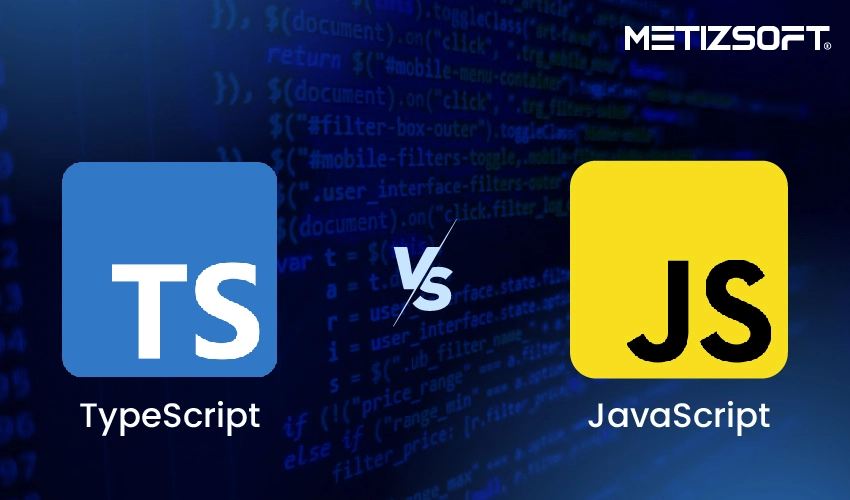
In a continuously evolving digital landscape, nothing is paramount. There will always be an alternative with more power and compatibility to take over. One of the best examples of this is TypeScript!
Previously, JavaScript dominated the tech market with its staggering features and offerings. The developer community renowned it as the sole premium server-scripting language.
The increasing popularity of JavaScript led to the development of many scalable applications, with almost 98.7% of websites (around 49,501,698 websites) made using a client-side programming language.
This undisputed dominance of JavaScript led Microsoft to develop TypeScrit, the most agile open-source programming language in 2012 to tackle large-scale applications.
Since then, the comparison and discussion regarding which is best among these two have started. It remains a hot topic among tech pundits almost a dozen years later.
In contrast, we have created this guide that dives into the relationship between JavaScript and TypeScript, its key differences, and each language’s unique advantages.
Table of Contents
Introduction to TypeScript
TypeScript, a powerful superset of JavaScript by Microsoft, tackles common pain points in web development. Its core strength lies in static typing, which catches errors early and improves code maintainability.
But that’s not all. Features like interfaces and classes enhance code organization, making large-scale projects more manageable.
In today’s dynamic web landscape, TypeScript is a game-changer. It fosters cleaner code, smoother collaboration, and a more efficient development experience, making it a must-have for modern web projects.
Key Features
- TypeScript’s static typing helps catch errors and prevents unexpected behavior in your application.
- Interfaces, enums, and other advanced features collaborate to create a more structured, predictable codebase.
- TypeScript has advanced tooling and IntelliSense support in modern IDEs.
- TypeScript allows the use of the latest ECMAScript features.
Use Cases
- TypeScript is mainly preferred for large-scale web applications where code maintainability is crucial.
- Multi-developer project collaboration.
- TypeScript is super flexible and integrates seamlessly with other languages and systems.
- Developing robust and scalable applications.
Introduction to JavaScript
JavaScript was introduced in 1995 as a client-side language for interactive web experiences. Its versatility has propelled it to server-side development with dynamic frameworks like Node.js and beyond.
This dynamic, open-source language empowers developers to build robust applications across the web stack, making it a strong choice for mid-tier projects and a linchpin in modern JavaScript development.
Key Features
- JavaScript’s dynamic typing allows for flexible code, adapting to different data types as needed.
- Every object in JavaScript has a hidden property called a prototype, which acts as a blueprint for the object.
- JavaScript is single-threaded and has a non-blocking event loop
- Asynchronous programming enhancing callbacks, promises, and async/await
- JavaScript is well-compatible with all major web browsers
- Facebook, Google, and many other tech giants use JavaScript due to its high-end scalability and compatibility.
Use Cases
- Add interactivity to websites.
- End-to-end Validating and processing form data.
- Collaborating with frameworks like React, Angular, or Vue.js to build dynamic web applications.
- Creating robust server-side applications with Node.js.
What Leads to TypeScript Development Despite having JavaScript?
JavaScript’s versatility has fueled its growth into server-side development as web applications scale and complexity increase. However, it was developed as a client-side language for interactive web pages.
While JavaScript’s versatility shines, large-scale projects can expose limitations. Dynamic typing makes early error detection tricky, unlike statically typed languages.
This is where TypeScript emerged, a JavaScript superset by Microsoft that tackles limitations like runtime errors with optional static typing.
This enables early bug detection and improved code organization through features like interfaces, classes, and modules, making it ideal for building robust and scalable web applications.
TypeScript seamlessly integrates with existing projects. It compiles plain JavaScript, allowing developers to leverage their favorite libraries and frameworks without a complete codebase rewrite.
TypeScript vs. JavaScript: Key Differences
Getting confused between TypeScript and JavaScript is normal. The margin is thin, and you must dive deep into its core prospects to make informed decisions for your next project. So, for your consideration, here’s a detailed comparison between TypeScript and JavaScript differences:
Learning Curve:
Built on JavaScript, TypeScript adds static typing and features for better organization. It’s ideal for large projects where code clarity and maintainability are crucial. To use TypeScript effectively, you must understand JavaScript and object-oriented programming (OOP) concepts.
A popular and beginner-friendly language, JavaScript is the foundation of web development alongside HTML and CSS. Due to its ease of use, it’s great for smaller projects or prototyping. While HTML defines the web page structure, JavaScript adds interactivity and dynamic behavior like animations.
Developers Community:
With its growing popularity, many tutorials and a vibrant TypeScript community have emerged to support your learning journey. However, a solid JavaScript foundation is recommended for a smooth transition.
On the other hand, JavaScript boasts a massive and established community, offering a vast library of resources, frameworks, and established coding practices.
Syntax:
TypeScript provides additional features like interfaces and enums, promoting better code organization and scalability for complex applications with object-oriented programming needs. It also supports modern ECMAScript 2015 features like modules, arrow functions, and classes, similar to JScript and .Net syntax.
JavaScript follows the ECMAScript definition and remains dynamically typed. However, it offers a rich set of programming paradigms, including functional, imperative, and event-driven styles. It also borrows familiar control flow structures like if statements and loops from C.
Performance:
TypeScript enforces static typing, requiring you to define variable types upfront. This catches errors early during development, leading to more reliable code. However, it adds a compilation step, introducing a slight overhead. The resulting JavaScript often runs as efficiently as its dynamically typed counterpart.
JavaScript is dynamically typed, offering flexibility but potentially leading to runtime errors if unexpected data types arise. While it lacks the compile-time safety of TypeScript, some argue its simplicity can lead to more optimized code in specific scenarios.
Tools & Framework:
TypeScript expands compatibility with existing JavaScript tools and frameworks while adding static typing for better code analysis. It shines in large-scale projects and collaborative environments, promoting code clarity and reducing errors. However, TypeScript reaches its full potential with statically typed frameworks like Angular, where its type safety truly complements the framework’s structure.
JavaScript, on a different scale, reigns supreme regarding ecosystem breadth. It seamlessly integrates with various popular tools and frameworks like React and Vue.js, making it an unparalleled choice for rapid prototyping and smaller projects.
Coding Complexities:
TypeScript’s static typing enforces defining types for variables, parameters, and return values. This strengthens code reliability by catching errors early but introduces some new syntax and concepts to learn.
Code Example:
Typescript
function greet(name: string): string {
return `Hello, ${name}!`;
}The above example “: string” specifies that the “name” parameter and the return value are expected to be strings.
JavaScript’s dynamic typing shines for its simplicity. Types are assigned automatically, making code more concise and accessible. This low barrier to entry makes JavaScript an excellent choice for beginners or rapid prototyping.
Code Example:
javascript
function greet(name) {
return `Hello, ${name}!`;
}Here, “name” can be of any type without explicit declaration. It allows super flexibility but potentially increases the risk of runtime errors.
Benefits of Choosing TypeScript over JavaScript
TypeScript comprises numerous benefits compared to JavaScript. Some of the countable benefits include:
- TypeScript is a typed language that quickly detects errors before your code runs, saving debugging time.
- TypeScript has an improved module system compared to JavaScript, which organizes code better and makes it more comprehensive for reusing components.
- TypeScript brings type inference, which helps write code more quickly and efficiently.
- TypeScript comes with an extensive toolset that makes development faster and easier.
- TypeScript is more maintainable than JavaScript, making it easier to read and understand.
Will TypeScript Ever Replace JavaScript?
The clear, concise, and straightforward answer to this question is NO!
JavaScript is the real OG of the software industry, and it is used for both client-side and server-side use. TypeScript, on the other hand, does not directly execute in web browsers; it transcompiles to JavaScript.
JavaScript wins in debugging and compilation because it runs directly in web browsers. This allows for quick iteration and on-the-fly adjustments.
However, TypeScript’s strength lies elsewhere. While it requires a compilation step before running in the browser, it offers features like static typing that can prevent errors early on, saving time in the long run.
Both languages have their specialties. It depends on your project’s needs, rapid prototyping might favor JavaScript’s ease of use, while larger projects might benefit from TypeScript’s ability to catch errors and improve code organization.
TypeScript vs JavaScript: Final Takeaway
The battle between JavaScript and TypeScript can be overwhelming. Both languages are powerful, but understanding their strengths will guide you to the perfect fit. JavaScript and TypeScript are web development powerhouses that cater to different needs.
As a business leader, navigating the world of web development languages can take time and effort. We hope this informative TypeScript vs JavaScript comparison guide simplifies the choice between JavaScript and TypeScript, focusing on how each impacts your project’s success.
Now, the choice is up to you and your business requirements. If you encounter obstacles when choosing or working on these two, contact Metizsoft the most trusted web app development company! Our consultants will guide you to the right decision, and our developers will ensure smooth execution.
AboutChetan Sheladiya
Related Posts
Why Choose WordPress To Boost Your Startup!
So you have got a business idea and want to implement an online startup. Table of Contents That’s great!Final Thoughts…...
What are The Ways to Improve Your AngularJS Web Development Performance?
AngularJS has become quite popular in recent years. It is a versatile framework that can be used to build any type of web...

